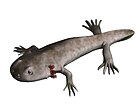
Lewisuchus is a genus of archosaur that lived during the Late Triassic. As a silesaurid dinosauriform, it was a member of the group of reptiles most commonly considered to be the closest relatives of dinosaurs. Lewisuchus was about 1 metre (3.3 ft) long. Fossils have been found in the Chañares Formation of Argentina. It exhibited osteoderms along its back.

The Santa Maria Formation is a sedimentary rock formation found in Rio Grande do Sul, Brazil. It is primarily Carnian in age, and is notable for its fossils of cynodonts, "rauisuchian" pseudosuchians, and early dinosaurs and other dinosauromorphs, including the herrerasaurid Staurikosaurus, the basal sauropodomorphs Buriolestes and Saturnalia, and the lagerpetid Ixalerpeton. The formation is named after the city of Santa Maria in the central region of Rio Grande do Sul, where outcrops were first studied.

The Caturrita Formation is a rock formation found in Rio Grande do Sul, Brazil. Its sediments were deposited in the Paraná Basin. The formation is from the Upper Triassic and forms part of the Santa Maria Supersequence in the upper section of the Rosário do Sul Group.

Australerpeton is an extinct genus of stereospondylomorph temnospondyl currently believed to belong to the family Rhinesuchidae. When first named in 1998, the genus was placed within the new family Australerpetontidae. However, studies published a few years later questioned the systematics used in the original description and included the genus within Archegosauridae. A study by Dias & Schultz (2003) reassigned Australerpeton to the family Rhinesuchidae within the suborder Stereospondyli based on an earlier evaluation of the family. In this study, the close similarities between Australerpeton and archegosaurids were attributed to convergent evolution as a result of similar semi-aquatic lifestyles. A redescription of the skeleton of this genus was published by Eltink & Langer in 2014, and the skull was redescribed in a follow-up study published by Eltink et al. in 2016. These studies, as well as a 2017 study focusing on rhinesuchids in general, confirmed that Australerpeton was a rhinesuchid rather than an archegosaurid. Fossils of the genus have been found in the Rio do Rasto Formation of Brazil.
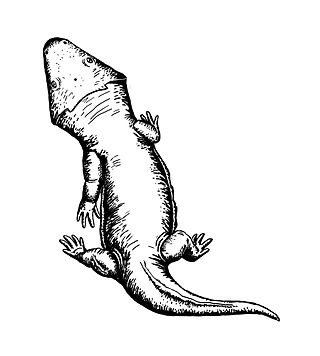
Deltasaurus is an extinct genus of Carnian temnospondyl amphibian of the family Rhytidosteidae.

Rhytidosteidae is a family of Temnospondyli that lived in the Permian and Triassic.

Lydekkerinidae is a family of stereospondyl temnospondyls that lived in the Early Triassic period. During this time period, lydekkerinids were widely distributed, with putative remains reported from Russia, Greenland, India, South Africa, Madagascar, Australia, and Antarctica. In contrast to most other stereospondyls, lydekkerinids were relatively small-bodied. The type genus is Lydekkerina, the namesake of the family and the best-known lydekkerinid.

The Sanga do Cabral Formation is an Early Triassic sedimentary rock formation found in Rio Grande do Sul, Brazil.
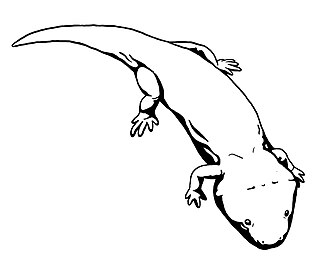
Indobrachyops is an extinct genus of temnospondyl amphibian from the Early Triassic of India. It is known from a nearly complete fossil skull that was first described by paleontologists Friedrich von Huene and M. R. Sahni in 1958 from the Panchet Formation in Raniganj Coalfield. Indobrachyops belongs to a group of mostly semi-aquatic temnospondyls called Stereospondyli, but its exact placement within the group has been uncertain since its first description.
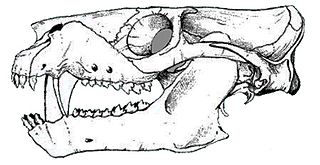
Trucidocynodon is an extinct genus of ecteniniid cynodonts from Upper Triassic of Brazil. It contains a single species, Trucidocynodon riograndensis. Fossils of Trucidocynodon were discovered in Santa Maria Formation outcrops in Paleorrota geopark Agudo. T. riograndensis was similar to Ecteninion lunensis from the Upper Triassic Ischigualasto formation of Argentina, but differed in several respects, including its larger size. It is known from a nearly complete holotype skeleton as well as a referred skull. The holotype skeleton had an estimated length of 1.2 meters, while the referred skull was 17% larger than that of the holotype. Trucidocynodon is considered one of the largest known carnivorous cynodonts from the Triassic, as well as one of the largest probainognathians in the entire Mesozoic.
Teyumbaita is an extinct genus of hyperodapedontine rhynchosaur from the Upper Triassic of southern Brazil. Its fossils were recovered from the early Norian-age Caturrita Formation, one of several fossiliferous formations exposed at Paleorrota Geopark in the state of Rio Grande do Sul. Teyumbaita is likely the youngest valid genus of rhynchosaur, as other members of the group likely died out before the start of the Norian.
Pneumatostega is an extinct genus of rhytidosteid temnospondyl from the early Triassic period of Cape Province of South Africa. It is known from the holotype BPI F981, a dorsal mould of a skull roof and from the referred specimen SAM 11188, partial skull fragments and postcranial remains recovered from the Lystrosaurus Assemblage Zone in the Beaufort Group near Middelburg. This genus was named by J. W. Cosgriff and J. M. Zawiskie in 1979, and the type species is Pneumatostega potamia.

Trucheosaurus is an extinct genus of rhytidosteid temnospondyl from the Late Permian period of the Sydney Basin, New South Wales, Australia. It is known from the holotype materials MMF 12697a, a partially complete skull, AMF 50977, an articulated postcranial skeleton and BMNHR 3728, the counterpart of both skull and postcranial skeleton, recovered from the Glen Davis Formation. This genus was named by Watson in 1956, and the type species is Trucheosaurus major.
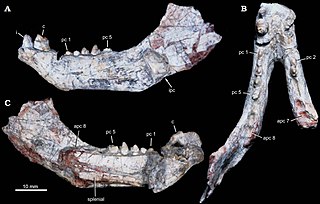
Candelariodon is an extinct genus of carnivorous probainognathian cynodonts from the Middle to Late Triassic Santa Maria Formation of the Paraná Basin in Rio Grande do Sul state, Brazil. Candelariodon is known from a partial mandible having some complete teeth. It was first named by Téo Veiga de Oliveira, Cesar Leandro Schultz, Marina Bento Soares and Carlos Nunes Rodrigues in 2011 and the type species is Candelariodon barberenai.
Pampadromaeus is an extinct genus of basal sauropodomorph dinosaurs known from the Late Triassic (Carnian) Santa Maria Formation of the Paraná Basin in Rio Grande do Sul, southern Brazil.

Derwentiinae is a subfamily of rhytidosteid temnospondyls from the Permian and Triassic periods of Australia and India. It includes the genera Arcadia, Deltasaurus, Derwentia, Indobrachyops, and Rewana. Derwentiinae was named in a 2011 study that analyzed the phylogenetic relationships of rhytidosteids. It was a replacement name for the family Derwentiidae, which was named in 2000.

Teyujagua is an extinct genus of small, probably semi-aquatic archosauromorph reptile that lived in Brazil during the Early Triassic period. The genus contains the type and only known species, T. paradoxa. It is known from a well-preserved skull, and probably resembled a crocodile in appearance. It was an intermediary between the primitive archosauromorphs and the more advanced Archosauriformes, revealing the mosaic evolution of how the key features of the archosauriform skull were acquired. Teyujagua also provides additional support for a two-phase model of archosauriform radiation, with an initial diversification in the Permian followed by a second adaptive radiation in the Early Triassic.
Brasinorhynchus is an extinct genus of derived stenaulorhynchine known from the late Middle Triassic Santa Maria Formation of Rio Grande do Sul, Brazil. It contains a single species, Brasinorhynchus mariantensis.
Bagualosaurus is a genus of sauropodomorph dinosaur from the Candelária Sequence of Brazil, dating to around 230 million years ago in the Carnian of the Late Triassic. It includes one species, Bagualosaurus agudoensis.

Venetoraptor is an extinct genus of lagerpetid archosaurs from the Late Triassic Santa Maria Formation of Rio Grande do Sul, Brazil. The genus contains a single species, V. gassenae, known from a partial skeleton.


















